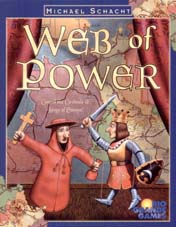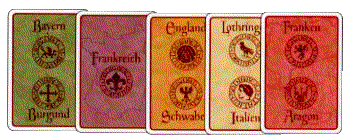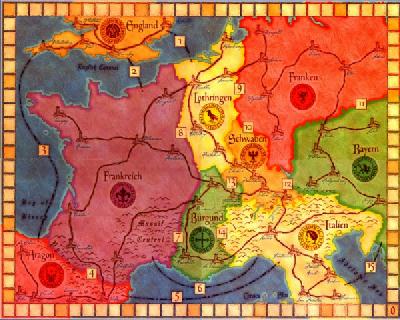
|
| Courtesy of Funagain Games |
The board is a colorful, antique depiction of 12th century Europe in which advisors and cloisters are battling for power and influence. The 9 countries in which they are battling are France, Aragon, Franken, Bavaria, Burgundy, Italy, Lothringen, England, and Swabia. Cloister pieces are played on the named villages in the countries, and advisor pieces are played on the country seal (the governmental seat). Once played, they are never moved.

|
| Courtesy of Rio Grande Games Rules |
There are many placement restrictions to help make a tight game. First, players must always place into one country during a turn. Players are restricted to a maximum of two piece placements, even if they have three usable cards. The first player to place into a country is limited to one piece. Because of this rule there is little advantage to going first in the game. Players often do not want to be the first into a country, and many games contain empty countries right up to near the end. Advisor placements are limited too. The total number of advisors is limited to the number of cloisters of the player who has the most cloisters in a country. So, if the first place cloister count is 3, only 3 advisors may be in that country. All these rules make for very tight and excruciating contests in a country. A margin of 1 piece can be tied fairly easily in one turn. A difference of 2 pieces is insurmountable!
There are only two scoring rounds in this game, and that's what gives this game its quick forward motion. Both scorings come when the draw pile is depleted, so its twice through the deck (55 cards) and the game is over. In the first round, only the cloisters are scored. The player with the most cloisters in a country receives a number of points equal to the total number of cloisters in the country. The second place players receives points equal to the first place player's count. So if Andrew and Beth have 5 and 3 pieces in a country, then Andrew will score 8 and Beth will score 5. Ties are graciously shared between the players. That is to say two players tying for first in a country receive points as if they were the sole first place player.

|
| Card | Number of cards | Number of villages |
|---|---|---|
| Franken/Aragon | 13 | 7/5 |
| Bayern/Burgund | 12 | 6/5 |
| Italien/Lothringen | 11 | 6/5 |
| England/Schwaben | 10 | 5/4 |
| Frankreich | 9 | 8 |
| Region | Alliances |
|---|---|
| England | 3 |
| Franken | 3 |
| Bayern | 3 |
| Italien | 4 |
| Aragon | 3 |
| Frankreich | 5 |
| Lothringen | 3 |
| Schwaben | 3 |
| Burgund | 3 |
Judging by the number of plays in our game group since we were introduced to this game in May, and by the number of session reports at the BoardGame Geek, this title is getting a good work out. Most of our games have been decided by fewer than 5 points, and it is not uncommon for 4 or 5 players to be grouped in a 10 point span. Many detractors of the game suggest that it is too dry or abstract. That may be true, but the game is over quickly for the amount of agonizing and calculating you must do to win.
The game also works well with 3 or 5 players. I enjoy the 5 player game more, because the board is more crowded, the scores are tighter, and there is more value in burning off cards in a country. For instance, if you have the majority in Schwaben, and several Schwaben cards have already been played, burning off 2 Schwaben cards as wild cards will help cement your majority there. With more players, it is less likely that one opponent will hold enough cards to make a comeback. Of course beware the player who plays two Frankreichs and a Schwaben to make a major rebound in this tiny nation.
Finally the artwork and component quality is excellent. Once again credit Franz Vohwinkel for the graphics. I have never seen an artist who can so skillfully change his style from game to game. Just look at the artwork in different styles he has created: Vampire, Ra, Space Walk, Big City. The list goes on and on. Most assuredly he will have his own wing in the Strategy Game Museum. Goldsieber also deserves credit for the nice cards and wooden tokens. Although everything is high quality, already my copy is showing signs of wear. Excellent game!